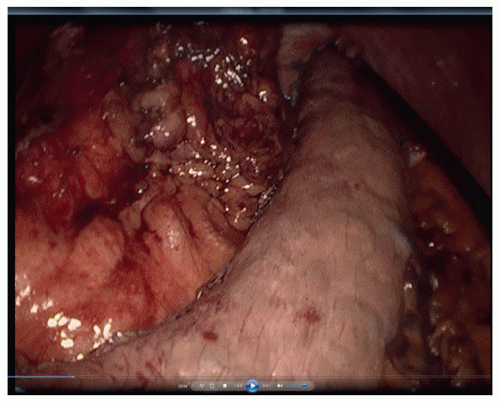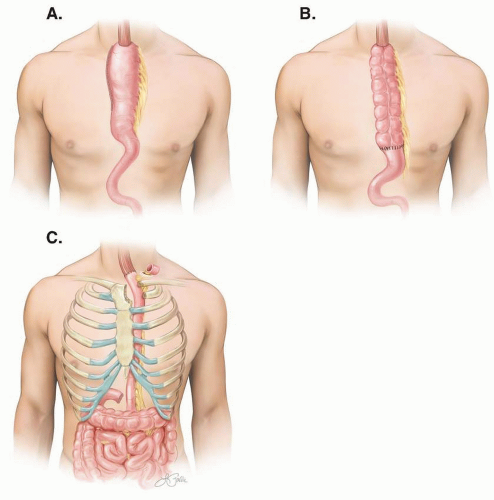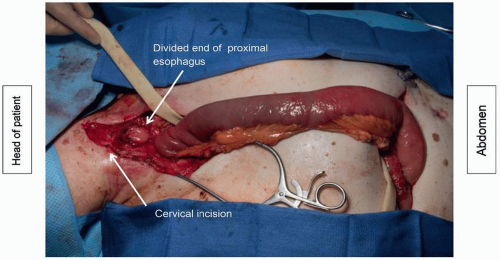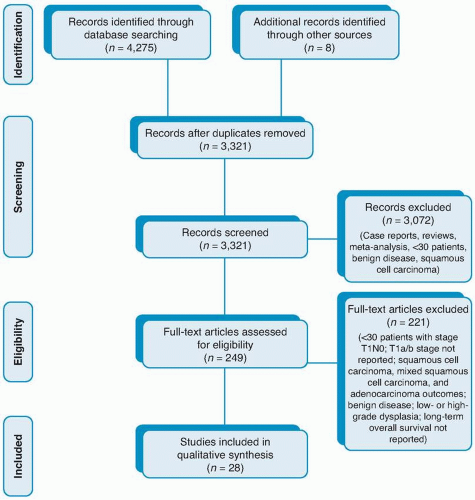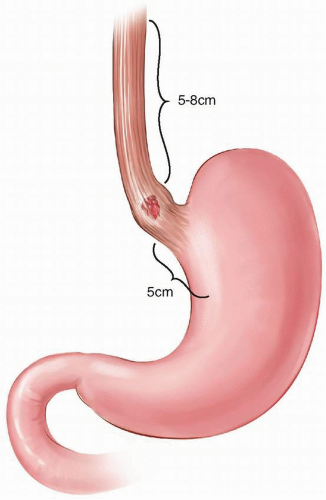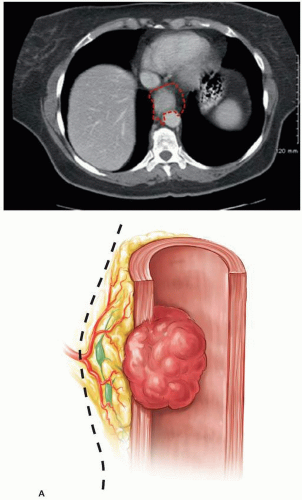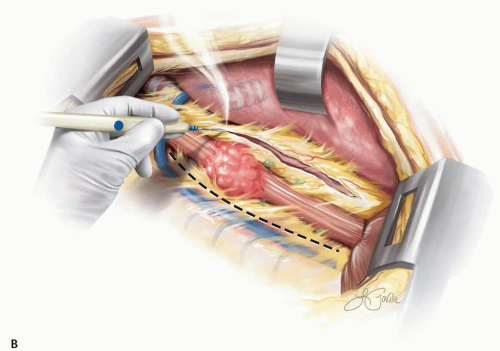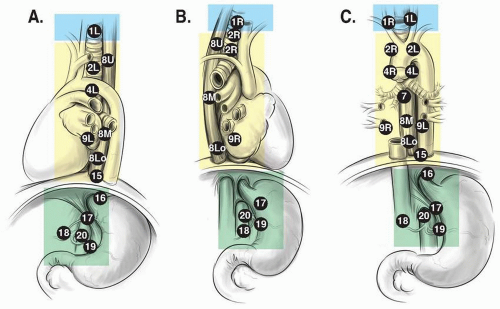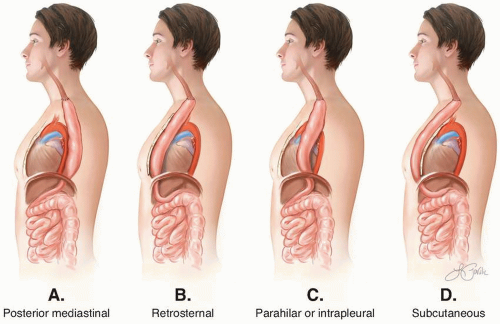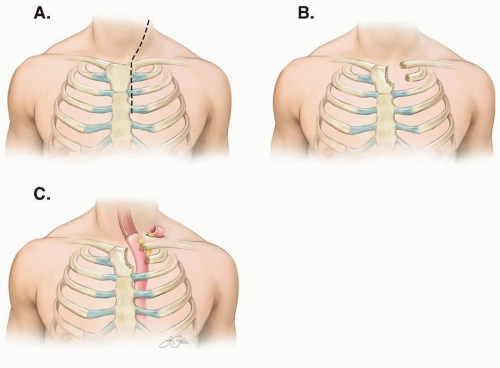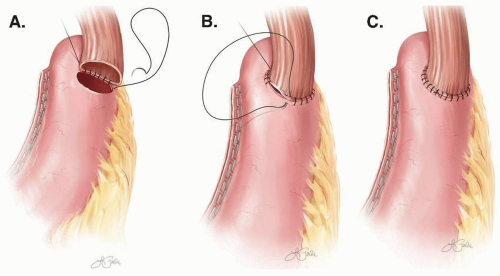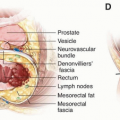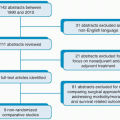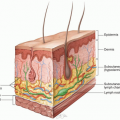Author, Year (Study Years) |
Patients |
Study Type |
Procedure(s) |
Outcomes |
Results |
Conclusions |
Comments |
Ancona et al, 200894 (1980-2006) |
Total: 98; T1a: 27; T1b: 71; SM1: 36; SM2: 7; SM3:28; SCC: 67; ADC: 31 |
Retrospective |
Ivor Lewis and McKeown |
R0 resection
Lymph node metastasis
Angiolymphatic invasion
Lymphocytic infiltration
5-yr overall survival (%)
10-yr overall survival (%) |
95 (97%)
T1a: 0; T1b: 20 (28%)
Absent: 53 (54%); present: 45 (45.9%)
High grade: 34 (34.7%); low grade: 64 (65.3%)
T1: 56.7; T1a: 77.7; T1b: 53.3; T1a/SM1: 67.3; SM2/3: 44.2; SCC: 43.3; ADC: 100
SCC: 37.3; ADC: 90.9 |
Independent predictive factors for lymph node metastasis were angiolymphatic invasion, depth of invasion, low-grade lymphocytic invasion, and neural invasion. |
Survival reporting by depth of invasion was of a mixed population of SCC and ADC. Survival reported according to histologic subtype did not further segregate by depth of invasion. |
Badreddine et al, 2010143 (1997-2007) |
Total: 80; T1b: 80; sm1:31; sm2: 23; sm3: 26; ADC: 100% |
Retrospective |
Ivor Lewis: 56; THE: 24 |
Mean follow-up (mo)
In-hospital mortality
30-d mortality
Lymph node metastasis
LVI
Overall survival (mo)
Disease-free survival (mo) |
40.5 ± 4
5 (6 %)
5 (6%)
T1b: 14 (17.5%); SM1: 4 (12.9%); SM2/3: 10 (20.4%)
T1b: 27 (34%); SM1:10 (32%); SM2/3: 17 (35%)
T1b: 46.5; SM1: 52; SM2/3: 38
T1b: 30; SM1: 35.3; SM2/3: 27.8 |
Superficial submucosal (sm1) invasion is a risk factor for lymph node metastasis (12.9%). Overall and cancer-free survival were not different between superficial submucosal (sm1) and deeper submucosal (sm2/3) invasion. |
All cases were adenocarcinoma. Adjuvant chemoradiation was administered to five patients with metastatic lymphadenopathy. |
Barbour, 2010113 (1991-2008) |
Tot: 85; T1a: 35; T1b: 49; Unknown: 1; ADC: 100% |
Retrospective |
Ivor Lewis: 6; MIE: 73; total gastrectomy: 5; proximal gastrectomy: 1 |
Median follow-up (mo)
In-hospital mortality
R0 resection
Lymph node metastasis
LVI
5-yr overall survival (%)
Disease-free survival (%) |
59
0
85 (100%)
T1a: 0; T1b: 8; Unknown: 1 No: 71 (83.5%); Yes: 14 (16.5%); T1a: 1; T1b: 13
T1a: 97; T1b: 65; SM1: 70 (NS); SM2: 60; SM3:71
T1a: 100; T1b: 70; SM1: 82 (NS); SM2: 60; SM3: 82 |
Four risk groups for lymph node metastases—I: T1a (0%); II: T1b, well/moderate differentiation/no LVI (4%); III: T1b, poor differentiation/no LVI (22%); IV: T1b with LVI (46%) |
Overall and diseasefree survival reported for the T1b cohort included eight patients with nodal metastasis (N1). |
Bogoevski et al, 201195 (1992-2007) |
Total: 113; HGIEN: 16; T1a: 41 T1b: 56 SCC: 56 ADC: 57 |
Retrospective |
THE (LR): 51; LR of the esophagogastric junction: 21; thoracoabdominal (ER): 41 |
Median follow-up (mo)
In-hospital mortality
R0 resection
Lymph node metastasis
Overall survival (all)
Overall survival T1b |
39
3 (2.7%)
113 (100%)
T1a: 0; T1b: 15 (27%)
LR: 203 mo, 5-yr 67.7%; ER: 88 mo, 5-yr 57.8%
LR: 63 mo, 5-yr 51.5%; ER: 85 mo, 5-yr 53.3% |
Patients with T1b submucosal invasion have a high (27%) rate of lymph node metastasis making them unsuitable for endoscopic treatment. LR esophagectomy is a valuable alternative to extended esophagectomy for T1b tumors with no difference in overall survival. |
The survival outcome reported mixed ADC and SCC histologies. Survival was not reported for T1a tumors and overall survival included 16 patients with HGIEN. |
Bolton et al, 200996 (1979-2007) |
Total: 133; T1a: 64; T1b: 69; ADC: 133 |
Retrospective |
Ivor Lewis: 57; THE: 63; 3-field: 7; MIE: 6 |
Median follow-up (mo)
R0 resection
Lymph node metastasis
LVI
3-yr overall survival (%)
5-yr overall survival (%) |
42
131 (98.5%)
T1a: 5%; T1b:23%
No: 102 (77%); Yes: 23 (17%); Missing: 8 (6%); T1a: 7%; T1b: 29%
T1a: 100; T1b: 90
T1a: 90; T1b: 69 |
In combination with submucosal invasion, tumor length >3 cm identifies a group of patients with T1 esophageal adenocarcinoma at high risk of lymph node involvement and decreased survival. |
All adenocarcinoma. Survival reported according to tumor depth included patients with nodal disease. |
Estrella et al, 201198 (1997-2010) |
Total: 99; T1a: 69; T1b: 30; ADC: 99 |
Retrospective |
THE: 43; Ivor Lewis: 41; MIE: 10; 3-field: 5 |
Lymph node metastasis
LVI
Mean RFS (mo) |
T1a: 1 (1.4%); T1b: 10 (33%)
All: 23 (23%); T1b: 18 (60%)
T1a: 108; T1b: 124 |
|
|
Kaneshiro et al, 2011114 (1983-2008) |
Total: 185; T1a: 150; T1b: 35 (sm1 only) |
Retrospective |
Esophagectomy |
Mean follow-up (mo)
Lymph node metastasis
Overall survival |
T1a: 7.7±4.6; T1b: 7.1±4
T1a: 1 (0.7%); T1b: 3 (8.6%)
No difference between groups |
|
No survival difference seen according to depth of invasion. T1a survival was reported according to the histologic sublayer and not in total. |
Kauppi et al, 2013115 (1984-2001) |
Total: 85; T1a: 35; T1b: 44; Unknown: 6; ADC: 85 |
Retrospective |
En bloc transthoracic: 36; THE: 39; vagalsparing esophagectomy: 5; EMR: 5 |
Median follow-up (yr)
In-hospital mortality
R0 resection (%)
Lymph node metastasis
5-yr overall survival (%)
10-yr overall survival (%)
5-yr disease-specific survival (%)
10-yr disease-specific survival (%)
5-yr RFS (%)
10-yr RFS (%) |
5
4 (5%)
Surgery: 100; EMR: 100 (number of resections: median 2, range 2-7)
T1a: 1/35 (3%); T1b: 6/44 (14%)
T1a: 73; T1b: 62
T1a: 58; T1b: 40
T1a: 92; T1b: 72
T1a: 86
T1b: 68
T1a: 89; T1b: 70
T1a: 89; T1b: 70 |
Recurrence of superficial ADC was the most important determinant of 5-year survival. Risk of recurrence of intramucosal tumors may be higher than reported. Beyond 5 years age-related disease is most predictive of mortality. |
All adenocarcinoma. Survival reported according to tumor depth included patients with nodal disease. |
Leers et al, 201199 (1985-2008) |
Total: 126; T1a: 75; T1b: 51; ADC: 126 |
Retrospective |
En bloc esophagectomy: 64; THE: 56; transthoracic esophagectomy: 6 |
Median follow up (mo)
LVI present
Lymph node metastasis
5-yr overall survival (%)
5-yr disease-specific survival (%) |
50
T1a: 6 (8%); T1b: 22 (43%)
T1a: 1 (1.3%); T1b: 11 (22%) (P = 0.0003); SM1: 21%; SM3: 26%
T1: 78; T1a: 82; T1b:71 (P = 0.25)
T1a: 98; T1a: 78 (P = 0.001); N0: 92; N1: 70 (P = 0.001) |
No significant difference in overall survival between T1a and T1b tumors. No difference in lymph node metastases between SM1 and SM3. |
All ADC. Main outcome measure was prevalence of lymph node metastases. Patients undergoing esophagectomy where < six lymph nodes were harvested were excluded. |
Lorenz et al, 2014100 (2000-2012) |
Total: 168; T1a: 42; m1-2: 10; m3-4: 32; T1b: 126; sm1: 37; sm2: 33; sm3: 56; ADC: 168 |
Retrospective |
En bloc esophagectomy: 130; limited esophagectomy: 30; THE: 2; MIE: 6 |
Median follow-up (mo)
Lymphatic invasion present
Vascular invasion present
Lymph node metastasis
Hospital mortality (%) 5-yr overall survival (%)
Tumor-specific survival (%) |
64
T1a: 13 (31%); m1-2: 0; m3-4: 13 (31%); T1b: 50; sm1: 12 (24%); sm2: 12 (24%); sm3: 26 (52%)
T1a: 0; m1-2: 0; m3-4: 0; T1b: 9; sm1: 3; sm2: 1; sm3: 5
T1a: 4; m 4: 4; T1b: 26; sm1: 3; sm2: 9; sm3: 14
2.97
All: 79; m1-2: 100; m3-4: 89.2; sm1: 83.5; sm2: 67.8; sm3: 70.4 (NS)
All: 79; m1-2: 100; m3-4: 96.4; sm1: 92.3; m2: 89.2 sm3: 81 (NS) |
The presence of lymph node metastasis was the most significant factor for 5-yr survival: 87.1 vs 56% (P <0.001). Lymph node infiltration was the only prognostic factor for overall survival, tumor-specific survival, and tumor recurrence in multivariate analysis. On univariate analysis, deeper submucosal infiltration (sm2,3) correlated with overall survival. |
All ADC. |
Manner et al, 2013130 (1996-2010) |
Total: 66; T1b sm1: 66; ADC: 66 |
Retrospective |
ER + APC: 66 |
Mean follow-up (mo)
CER
Number of ERs to obtain CER
Long-term remission
Metachronous neoplasias
Mean period from CER to diagnosis of metachronous neoplasias (mo)
Lymph node metastasis
5-yr overall survival (%) |
47±29.1
Overall: 53/61 (86.9%); lesions <2 cm: 30/31 (97%); lesions ≥2 cm: 23/30 (77%)
2.6±2.9
Overall: 51/61 (83.6%); lesions <2 cm: 28/31 (90%); lesions ≥2 cm: 23/30 (77%)
10/53 (19%)
22
1/53 (1.9%)
84 |
Risk of developing lymph node metastases after EMR is lower than the risk of surgery. No tumorassociated deaths were observed. |
Main outcome measure was CER in T1b ADC. After EMR, thermal ablation of the residual Barrett’s segment was done for prophylaxis of metachronous lesions in 79% of patients. All MN treated endoscopically. |
Manner, et al, 2017229 |
Total: 62; T1b sm2: 23; T1b sm3:39; ADC: 62 |
Retrospective |
T1b sm2—hisLR: endoscopic resection: 3; esophageal resection: 9; hisHR: endoscopic resection: 1; esophageal resection: 10. T1b sm3—hisLR: Endoscopic resection: 0; Esophageal resection: 7; hisHR: endoscopic resection: 0; esophageal resection: 7. Note: A total of 58 patients underwent esophageal resection for whom pT1b sm2 vs. sm3 status was not clarified. |
Lymph node metastasis
Lymph node metastasis per histologic risk
30-d mortality of surgery
Mean follow-up with EUS after endoscopic resection (mo) |
T1b sm2: 5/23 (21.7%); T1b sm3:14/39 (35.9%)
T1b sm2—hisLR: 8.3% (1/12); hisHR: 36.3% (4/11); combLR: 0% (0/5); combHR: 27.8% (5/18). T1b sm3—hisLR: 28.6% (2/7); hisHR: 37.5% (12/32); combLR: 25% (1/4); combHR: 37.1% (13/35)
1.7% (1/58)
41-43 |
In ADC with pT1b sm2/3 invasion, the frequency of lymph node metastasis depends on macroscopic and histologic risk patterns. The rate of lymph node metastasis appears to be higher than the mortality risk of surgery. Whether a highly selected group of pT1b sm2 patients with a favorable risk pattern may be candidates for endoscopic therapy cannot be determined until the results of larger case volumes are available. |
There was no treatmentrelated mortality of ET. Rate of lymph node metastasis was analyzed depending on risk patterns—hisLR): G1-2, L0, V0; hisHR: ≥1 criterion not fulfilled; macLR: gross tumor type I-II, tumor size ≤2 cm; macHR: ≥1 criterion not fulfilled; combLR: hisLR1macLR; combHR: at least 1 risk factor. |
Ngamruengphong et al, 2013116 (1998-2009) |
Total: 1,618; Endoscopic—Tis: 55; T1a: 174; T1b: 39; T1, NOS: 38; Surgery—Tis: 110; T1a: 561; T1b: 523; T1, NOS: 118 |
Retrospective from SEER database |
Endoscopic therapy: 306 (19%); ER: 149 (48.7%); ER NOS: 61 (19.9%); ER + PDT: 16 (5.2%); ER + electrocautery: 16 (5.2%); ER + laser: 15 (4.9%); ER + cryosurgery 3 (1.0%); PDT: 29 (9.5%); laser treatment: 10 (3.3%); cryosurgery: 5 (1.6%); electrocautery: 1 (0.3%); ablation, NOS: 1 (0.3%); surgery: 1,312 (81%); Partial esophagectomy + partial gastrectomy: 608 (46.3%); partial esophagectomy + gastrectomy, NOS: 210 (16.0%); partial esophagectomy: 237 (18.1%); total esophagectomy: 79 (6.0%); total esophagectomy + gastrectomy, NOS: 51 (3.9%); esophagectomy, NOS: 127 (9.7%) |
Median follow-up (mo)
Overall survival for T1b vs Tis/T1a (HR)
ECSS T1b vs Tis/T1a (HR)
Overall survival for surgery vs. ET (HR)
ECSS surgery vs. ET (HR)
5-yr overall survival Tis/T1 (%)
5-yr overall survival Tis/T1a (%)
5-yr overall survival T1b (%)
5-yr ECSS Tis/T1 (%)
5-yr ECSS Tis/T1 (%)
5-yr ECSS Tis/T1a (%)
5-yr ECSS T1b (%)
Deep margin on EMR |
36
1.37 (95% CI, 1.12-1.69)
1.65 (95% CI, 1.28-2.16)
Tis/T1: 1.21; Tis/T1a: 1.29; T1b: 0.97 (NS)
Tis/T1: 0.74; Tis/T1a: 0.69; T1b: 0.46 (NS)
ET: 58; surgery: 70 (P = 0.003)
ET: 60; surgery: 76 (P = 0.002)
Surgery: 66; ET: 64 (P = 0.26)
Surgery: 81; ET: 77 (P = 0.26)
Surgery: 81; ET: 77 (P = 0.26)
Surgery: 83; ET: 84 (P = 0.64)
Surgery: 89; ET: 71 (P = 0.31)
Negative: 53; positive: 26; not reported: 2 |
Older age and radiation therapy were associated with worse overall survival and ECSS. Submucosal invasion was significantly associated with worse overall survival and ECSS. Outcomes were not different for surgery compared with ET when stratified by depth of invasion. |
All ADC. 15% received radiation therapy. |
Nurkin et al, 2014117 (2001-2012) |
Total: 81; Tis: 37; T1a: 10; at least T1a: 13; T1b: 6; at least T1b: 15 |
Retrospective |
EMR: 77; ESD: 4; esophagectomy: 14 |
Median follow-up (yr)
5-yr overall survival (%)
5-yr disease-free survival (%) |
3.25
T1a: 83
T1a: 100; T1b: 100 |
ER can result in a cure for T1a disease. Patients with T1b disease, low-risk features, and negative deep margins can be observed. Obtaining a negative margin on EMR was a predictor of improved 5-yr disease-free and overall survival. |
Of T1b patients, only two were observed, two had esophagectomy, and two chemoradiotherapy. Series is too small to support the conclusion for T1b. |
Oh et al, 2006118 (1987-2006) |
Total: 78; T1a: 78 |
Retrospective |
En bloc esophagectomy: 23; THE: 31; vagal-sparing esophagectomy: 20; transthoracic esophagectomy: 4 |
5-yr overall survival (%)
Lymph node metastasis (in patients undergoing en bloc resection)
Overall mortality rate |
88%
1/23 (4%)
2.6% |
Vagal-sparing technique had less morbidity than other forms of resection and no mortality. Survival after all types of resection was similar. |
|
Pech et al, 2005123 (1996-2002) |
Total: 66; HGD: 35; T1a: 31 |
Prospective |
PDT-ALA |
Median follow-up (mo)
Complete remission
Recurrence
5-yr overall survival (%)
5-yr disease-specific survival (%) |
HGD: 37; T1a: 36
HGD: 34/35 (97%); T1a: 31/31 (100%)
HGD: 6/34 (18%); T1a: 9/31 (29%)
HGD: 97; T1a: 80
HGD: 89; T1a: 68 |
Local recurrence in 10 patients in the T1a group. |
|
Pech et al, 2011119 (1996-2009) |
Total: 114; T1a: 114 |
Retrospective |
Transthoracic esophagectomy: 38; ER + APC: 76 |
Median follow-up (yr)
Complete remission
Major complications (%) 90-d mortality rate
Overall rate of recurrence/metachronous neoplasia (%)
Long-term remission rates allowing for repeat endoscopic therapy (%)
Disease-free survival rate
Lymph node metastasis |
Esophagectomy: 3.7; ER + APC: 4.1
Esophagectomy: 38/38 (100%); ER + APC: 75/76 (98.7%)
Esophagectomy: 32; ER + APC: 0
Esophagectomy: 1/38 (2.6%); ER + APC: 0/76 (0%)
ER + APC: 6.6
Esophagectomy: 100; ER + APC: 98.7
Esophagectomy: 100%; ER + APC: 75/76 (98.7%)
Esophagectomy: 0/38 (0%); ER + APC: 0/76 (0%) on follow-up EUS |
Esophagectomy was associated with a higher morbidity rate and a mortality rate of 2.6% vs. 0% mortality in the EMR cohort (difference between cohorts not significant). Recurrence rate was higher in the EMR cohort (difference not significant). Age was a prognostic factor for survival (HR, 1.13; 95% CI, 1.04-1.23 for each year, with P = 0.005). |
Baseline characteristics were comparable between the two cohorts. Only significant difference between cohorts was Barrett’s length with shorter Barrett segments in the EMR cohort. |
Pech et al, 201493 (1996-2010) |
Total: 1,000; T1a: 1,000 |
Prospective |
ER |
Mean follow-up (mo)
Complete remission of neoplasia
Long-term complete remission rate
Recurrence of neoplasia (HGD or adenocarcinoma)/metachronous lesions
5-yr overall survival (%)
10-yr overall survival (%)
5-yr disease-specific survival (%) |
56.6
963 (96.3%)
938 (93.8%)
140/963 (14.5%)
91.5
75
87.1 |
No mortality and major complications were <2% (bleeding, perforation). Only factor negatively associated with complete remission was presence of long segment BE (P = 0.0001). Poorly differentiated mucosal ADC (G3) was associated with significantly higher risk of recurrence and failure of endoscopic treatment than patients with well-differentiated or moderately differentiated mucosal ADCs. |
Repeat endoscopic treatment was successful in 82.1%. Surgery was necessary in 3.7% after failure of endoscopic therapy. |
Peyre et al, 2007120 |
Total: 109; HGD: 36; T1a: 73 |
Retrospective |
Vagal-sparing esophagectomy: 49; THE: 39; en bloc esophagectomy: 21 |
30-d mortality (%)
Duration of follow-up (mo) |
Vagal-sparing esophagectomy: 2; THE: 5; en bloc esophagectomy: 0
Vagal-sparing esophagectomy: 39; THE: 25; en bloc esophagectomy: 60 |
Length of hospital stay and the incidence of major complications was significantly reduced with vagalsparing esophagectomy compared with transhiatal or en bloc resection. Recurrent cancer has developed in only one patient. |
|
Prasad et al, 2009110 (1998-2007) |
Total: 178; T1a: 178 |
Retrospective |
Endoscopic: 132; EMR alone 75 (57%); EMR+PDT 57 (43%); surgery: 46; THE: 20 (43%); transthoracic: 29 (57%) |
Mean follow-up (mo)
Median number of endoscopic treatments
Endoscopic remission rate
Lymph node metastasis
Follow-up (person-yr)
Cumulative mortality
Overall mortality, incidence rate (person-yr)
Recurrent cancers
Recurrence, incidence rate (person-yr)
5-yr overall survival (%)
5-yr disease-specific survival (%) |
Endo: 43; Surgery: 64
1 (IQR, 1-2)
124/132 (94%)
Surgery: 4/46 (8.6%)
Endoscopic: 464.6; surgery: 244
Endoscopic: 23/132 (17%); surgery: 9/46 (20%)
Endoscopic: 4.9/100; surgery: 3.7/100
Endoscopic: 16 (12%); surgery: 1 (2%)
Endoscopic: 5.5/100; surgery: 0.56/100
Endoscopic: 83; surgery: 95
Endoscopic: 80; surgery: 97 |
Cumulative mortality in the endoscopic group (17%) was comparable with the surgery group (20%) (P = 0.75). Possible predictors of recurrence: presence of residual BE (without dysplasia), increasing length of BE segment at baseline, and presence of a carcinoma detected after 6 months of surveillance for HGD. |
Rice et al, 2001101 (1985-1999) |
Total: 122; HGD: 38; T1a N0: 51; T1a N1: 2; T1b N0: 25; T1b N1: 6 |
Retrospective |
Esophagectomy—THE: 75; thoracotomy/abdominal incision: 46; laparotomy: 1 |
Follow-up (mo)
Operative mortality
Lymph node metastasis
Overall survival (%)
Overall survival:T1a
Overall survival: T1b (%)
Number of deaths (n) |
Mean: 47±41; median: 38
2.5% (3/122)
T1a: 2/122 (2%); T1b: 6/122 (5%)
5-yr: 77; 10-yr: 68
5-yr: 77%; 10-yr: 65%
5-yr: 61; 10-yr: 40 (P = 0.009)
Cancer related: 13; noncancer related: 6 |
Depth of invasion predicted survival on univariate analysis but on multivariate analysis, lymph node metastasis was most predictive of poor long-term survival. |
|
Saha et al, 2009121 (2000-2009) |
Total: 55; T1: 44; T1b: 11 |
Retrospective |
Esophagectomy—Ivor Lewis: 24; THE: 20 |
Median followup (mo)
Operative mortality
Complications
Lymph node
metastasis
1-yr disease-free survival (%)
3-yr survival (%)
Recurrence rate (%) |
44
2 (5%)
9 (20%)
2 (4%, both T1b)
95
93
7 |
Differentiation appears to be a marker of poor prognosis. |
|
Sepesi et al, 2010102 (2000-2008) |
Total: 54; T1a: 25; T1b: 29; SM1: 14; SM2: 11; SM3: 6 |
Retrospective |
En bloc esophagectomy: 10; THE: 39; Ivor Lewis: 2; vagal sparing esophagectomy: 2; McKeown: 1 |
Median follow-up (mo)
LVI
Lymph node metastasis
5-yr overall survival, estimated (%)
Died with recurrence |
42
7 (13%)
Total: 9 (17%); T1a: 0 SM1: 3/14 (21%); SM2: 4/11 (36%); SM3: 2/4 (50%)
T1a: 85; T1b: 60 (P = 0.08)
5/15 (33%) |
Nodal metastasis rate was significantly different for T1a and T1b tumors but not different by depth of submucosal invasion. Nodal metastasis in submucosal tumors was high. |
|
Sgourakis et al, 2013124 (1997-2011) |
Total: 4,241; endoscopic: 2,092; LGD: 4%; HGD/CIS: 33.6%; T1a: 54%; T1b: 16%; surgery: 2,149 included ADC and SCC |
Systematic review |
Endoscopic therapy—EMR and/or ESD (42 studies); APC (3 studies); PDT (2 studies); RFA (2 studies); surgery—various (38 studies) |
LVI
Microvascular invasion
Lymph node metastasis (11 studies)
Mean follow up (mo)
EMR resection margins (18 studies)
Endoscopic local recurrence (30 studies)
Development of metachronous lesions after endoscopic management (10 studies) |
EMR and/or ESD: 0%-30%
EMR and/or ESD: 0-33%
Endoscopic—31/371 (8%); ADC: 5%; SCC: 1%; surgery—888/2,149 (41%); T1b: ADC: 26%; SCC: 45%
Endoscopic: 12-62
Positive: 294/880 (3%); ADC: 9%; SCC: 7%
0%-17%; ADC: 0.8%; SCC: 1%
2%-14%; ADC: 6%; SCC: 1% |
In endoscopically managed patients, local tumor recurrence was predicted by poor differentiation and piecemeal resection; lymph node positivity by LVI. In surgically resected patients for ADC, the best predictor for lymph node positivity was LVI. |
Includes both ADC and SCC. A significantly greater number of SCC patients were submitted to surgery than ADC patients. For surgically resected patients, there were significant differences in patients with positive lymph nodes between ADC and SCC. |
Stein et al, 2000104 (1982-1999) |
Total: 94; T1a: 38; T1b: 56 |
Retrospective |
Esophagectomy—subtotal: 71; limited resection/jejunal interposition: 24 |
Median follow-up (mo)
30- and 90-d mortality (%)
Complications
Lymph node metastasis
5-yr overall survival (%) |
15
Subtotal: 4.2; limited: 0
Subtotal: 31/71 (43.7%); limited: 5/24 (20.8%)
T1a: 0; T1b: 10/56 (18%)
T1a: 85; T1b: 78 |
No survival difference T1aN0 and T1bN0. Lymph node metastasis had a significant effect on survival. |
|
Stein et al, 2005103 (1990-2004) |
Total: 290; ADC: 157; SCC:133; HGD: 14; T1a: 82; ADC: 57; SCC: 25; T1b: 194; ADC: 87; SCC: 107 |
Retrospective |
Esophagectomy—abdominothoracic: 146; radical transhiatal: 144 |
Median follow-up (mo)
Postoperative mortality
Lymph node metastasis ADC
5-yr overall survival (%) |
66
5/290 (1.7%)
T1a: 0; T1b: 18/87 (20.7%)
ADC: 83.4; SSC: 62.9 |
Presence of lymph node metastasis and histologic tumor type were the only significant factors affecting survival favoring node negative disease and adenocarcinoma. |
|
Tian et al, 2011144 (1995-2010) |
Total: 68; all T1b |
Retrospective |
EMR: 68; esophagectomy: 39 |
In-hospital mortality
Lymph node metastasis at esophagectomy
Median survival (mo)
Overall mortality (%)
5-yr survival (%)
Risk factors for overall survival, univariate (HR, 95% CI) |
1/39 (2.6%)
13 (33%)
All: 39.5 (IQR, 23.9-70.3); EMR: 34.8 surgery: 48.9 (P = 0.09)
EMR: 37.9; surgery: 25.6 (P = 0.28)
All: 69.5
Surgery: 0.4, 0.2-1.1 (P = 0.09); lymph node metastasis: 6.8, 1.4-33.8 (P = 0.02) |
Patients who underwent esophagectomy after EMR lived longer but not significantly so. Most of the EMR-only mortality was in patients deemed not fit for esophagectomy. |
29 patients did not undergo esophagectomy and were treated with CRT (5), continued endoscopic therapy (15), both (5), or neither (4). |
Westerterp et al, 2005105 |
Total: 120; HGD: 13; T1: 107 |
Retrospective |
THE |
Median follow-up (mo)
Lymph node metastasis
5-yr recurrence free (%)
5-yr RFS (%)
Recurrence-free period risk for T1N0
5-yr disease-free survival (%) |
44
T1a/T1b-sm1: 1/79 (1.3%); T1-sm2/3: 18/41 (44%)
T1a/T1b-sm1: 97; T1-sm2/3: 57 (P <0.0001)
T1a/T1b-sm1: 80; T1-sm2/3: 42 (significant)
T1sm2-3 HR, 7.5, (95% CI, 2.0-2.7 vs. T1m1-3/sm1)
68 (all) |
N-stage was the only independent predictor of recurrence at 5 years but when excluded, depth of invasion was significant. |
|
SCC, squamous cell carcinoma; ADC, adenocarcinoma; THE, transhiatal esophagectomy; LVI, lymphovascular invasion; MIE, minimally invasive esophagectomy; HGIEN, high-grade intraepithelial neoplasia; LR, limited resection; ER, extended resection; EMR, endoscopic mucosal resection; RFS, relapse free survival; APC, argon plasma coagulation; CER, complete endoluminal remission; MN, metachronous neoplasias; hisLR, histologically low risk; hisHR, histologically high risk; combLR, combined low risk; combHR, combined high risk; macLR macroscopically low risk; macHR, macroscopically high risk; NOS, not otherwise specified; PDT, photodynamic therapy; HR, hazard ratio; ECSS, esophageal cancer specific survival; NS, not significant; ESD, endoscopic submucosal dissection; HGD, high grade dysplasia; ET, endoscopic therapy; ALA, 5-delta-aminolevulinic acid; CI, confidence interval; IQR, interquartile range; BE, Barrett’s esophagus; LGD, low-grade dysplasia; CIS, carcinoma in situ; RFA, radiofrequency ablation; CRT, chemoradiotherapy. |
